
The mullets or grey mullets are a family (Mugilidae) of ray-finned fish found worldwide in coastal temperate and tropical waters, and some species in fresh water. Mullets have served as an important source of food in Mediterranean Europe since Roman times. The family includes about 78 species in 26 genera.

The goatfishes are fish of the family Mullidae, the only family in the order Mulliformes. The family is also sometimes referred to as the red mullets, which also refers more narrowly to the genus Mullus.

The flathead grey mullet is an important food fish species in the mullet family Mugilidae. It is found in coastal temperate, tropical and subtropical waters worldwide. Its length is typically 30 to 75 centimetres. It is known with numerous English names, including the flathead mullet, striped mullet, black mullet, bully mullet, common mullet, grey mullet, sea mullet and mullet, among others.
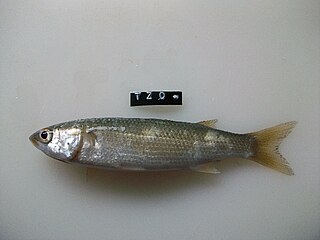
The South African mullet, also called a harder mullet or simply harder, is a species of mullet. It is found in South African coastal waters from Walvis Bay (Namibia) to KwaZulu-Natal, and grows to a maximum length of 40.5 cm (15.9 in). The person the specific name honours was not recorded by Andrew Smith when he described this species but it is most likely to be John Richardson (1787-1865), the Scottish naturalist, surgeon and Arctic explorer.
Chelon is a genus of mullets found in coastal marine waters, estuaries and rivers in the Atlantic Ocean and Arabian Sea.

Crenimugil is a genus of mullets found in coastal marine waters and rivers in the Indo-Pacific region.
Lethrinops argenteus is a species of cichlid endemic to Lake Malawi. This species grows to a length of 19 centimetres (7.5 in) TL.
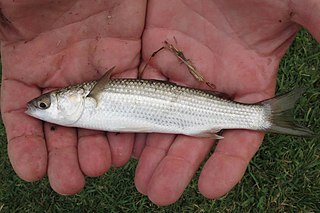
The freshwater mullet is a species of ray-finned fish in the family Mugilidae. It is endemic to South Africa.

The thicklip grey mullet, Chelon labrosus, is a coastal fish of the family Mugilidae. It typically is about 32 cm (13 in) long, with 75 cm (30 in) being the maximum recorded. It is named after its thick upper lip and silvery-grey appearance.

Several species of fish are claimed to produce hallucinogenic effects when consumed, a condition known as ichthyoallyeinotoxism. For example, Sarpa salpa, a species of sea bream referred to as the "dream-fish", is commonly claimed to be hallucinogenic. These widely distributed coastal fish are normally found in the Mediterranean and around the Iberian Peninsula, west to the Azores and along the west and south coasts of Africa. Occasionally they are found in British or more northerly waters. They may induce hallucinogenic effects similar to LSD if eaten. However, based on the reports of exposure they are more likely to resemble hallucinogenic effects of deliriants than the effects of serotonergic psychedelics such as LSD. In 2006, two men who apparently ate the fish experienced hallucinations lasting for several days. The likelihood of hallucinations depends on the season. Sarpa salpa is known as "the fish that makes dreams" in Arabic.

The so-iuy mullet, also known as the haarder, redlip mullet or so-iny mullet, is a species of ray-finned fish in the family Mugilidae.

Diplodus sargus, the sargo, common white seabream, or white seabream is a species of marine ray-finned fish belonging to the family Sparidae, which includes the seabreams and porgies. This fish is found in the eastern Atlantic Ocean and in the Mediterranean Sea. It is a target species for commercial fisheries and is grown in aquaculture. D. sargussensu lato was formerly thought to be a widespread species in the eastern Atlantic and western Indian Oceans but the taxa outside of D, sargussensu stricto are now recognised as valid species and are part of the D. sargus species complex.
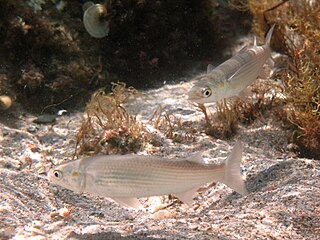
The golden grey mullet is a fish in the family Mugilidae.
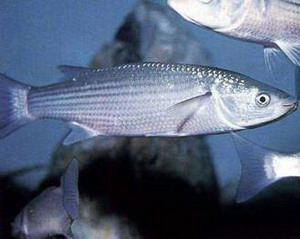
The thinlip mullet is a species of fish in the family Mugilidae. It is found in shallow European waters and is a migratory species.
The diamond mullet, is a species of mullet and is also known as the Ord River mullet. This species lives in both brackish or freshwater. Adult fish are found in estuaries, coastal waters and in some cases, ascending rivers into fresh water.
The pinkeye mullet, also known simply as pinkeye, or freshwater mullet, Richmond mullet, or river mullet, is a species of ray-finned fish from the grey mullet family Mugilidae and the only species in the genus Trachystoma. It is endemic to northeastern Australia where it occurs from the Burnett River in Queensland to the Clyde River in New South Wales. It is a subtropical species which is found in deep, slow flowing sections of rivers as well as in estuaries although it moves into coastal seas to spawn. It feeds mainly on algae and plant material, as well as detritus and benthic invertebrates.

Pomadasys argenteus, the silver grunt, silver javelin, grunter bream, small-spotted grunter-bream, small-spotted javelin fish, trumpeter or white-finned javelin fish, is a species of marine ray-finned fish, a grunt from the family Haemulidae. This species has a wide Indo-Pacific distribution. It is the type species of the genus Pomadasys.

The Burmese mullet is a species of freshwater ray-finned fish, a mullet belonging to the family Mugilidae. It is the only species in the genus Sicamugil. It is found in the drainage systems of the Sittang and Irrawaddy rivers in Myanmar.
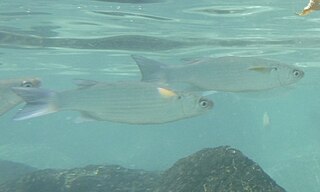
Crenimugil heterocheilos, the half fringelip mullet, is a species of ray-finned fish in the family Mugilidae. It is found throughout the Indo-Pacific Ocean.















